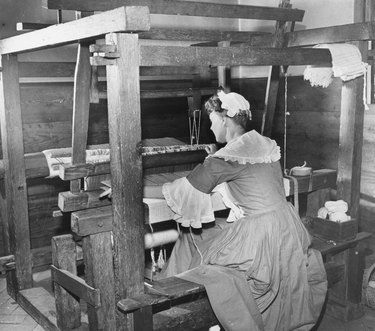
Weaving during colonial times was not widely practiced until heavy taxation and politics ended the importation of textiles from England. Then weaving became not only an honored craft, but also a basic necessity and an act of autonomy. Harvard and Yale graduates in 1768 and 1769 wore homespun clothing to their graduations as an act of patriotism and defiance against the unpopular British taxes.
Tools of the Trade
Video of the Day
While England had a mechanized and efficient textile industry by the 1700s, the colonies had to start from scratch. The Northeastern colonies in particular took on the role of weavers and adopted the use of two different types of spinning wheels, a walking wheel for cotton and a Saxony wheel for flax, hemp and wool. They also used two types of looms to weave fabric: Spain's cantilever loom developed in the 11th century, and England's four-post box loom developed in the 16th century.
Video of the Day
Materials Used for Weaving
One popular material used for weaving was hemp, which grew wild in the colonies and which the natives used to make clothing, nets and rope. Wool was also popular, though sheep bred in the colonies had coarser wool than those in Britain. It also took time to increase the wool population, which was prey for wolves and Native Americans. Cotton, though widely produced in the Southern colonies, was not a popular material for weaving- -- it was considered too difficult to spin until the invention of the cotton gin in 1793. Virginia and Georgia produced some silk, but like cotton, it was mainly exported as raw material. The most popular material for weaving during colonial times was flax, which was planted on most farms, matured quickly and was easier than other materials to spin and process.
Popular Dyes
Once the materials were spun and woven into cloth, they had to be dyed. Popular dyes during colonial times were imported from a variety of locations. Red dye was made from an insect imported from the Spanish colonies in South America. Native Americans taught colonists how to use walnuts to produce brown dyes and the indigo flower native to South Carolina to produce blues. Tumeric was imported from India to produce yellow and campeche tree was imported from Spain to create purple dyes.
Who Were The Weavers?
Though many may assume that handcrafts such as weaving was women's work, in fact, it was mostly men who were weavers in colonial times. However, unmarried women did much of the spinning of raw materials, which is where the term "spinster" originated.
Many English men came to New England as indentured servants who worked as weavers, filling the desperately needed ranks of fabric producers. Professional weavers, on the other hand, were given land as an incentive to move to the colonies. Many Dutch weavers and spinners settled in the middle colonies and Pennsylvania's Philadelphia and Germantown with their population hailing from the UK, The Netherlands and Germany established themselves as some of the first textile producing centers. In the South, most of the weaving was done by slaves to produce bedding and clothing, though some estates also produced silks and linens.